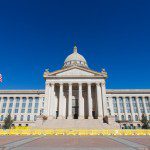Maps of Oklahoma City show Oklahoma’s State Capitol building sitting on North Lincoln Boulevard. It could also be said that the building sits at the intersection of time and action.
With Oklahoma’s defining building approaching triple digits in terms of age, the Capitol is facing a day of reckoning with regards to its physical condition. Nearly a century of gravity and manic Oklahoma weather have taken a toll on both the interior and exterior of the seemingly rock solid capitol, and the tangible evidence of that toll is making more than a few state officials take notice.
“I’m told its problems are not inconsistent with a building nearly 100 years old,” says state finance office director Preston Doerflinger. However, he says, “Our State Capitol is steadily deteriorating, and the damage will only accelerate if significant repairs are not made soon.”
Doerflinger cites the crumbling exterior among the Capitol’s most urgent needs. And it’s for more than just the obvious safety issues. “As Governor (Mary) Fallin has said, it’s embarrassing that visitors to the Capitol are greeted by yellow barricades and scaffolding erected to protect them from falling chunks of limestone.”
John Morrison, administrator of Capitol Asset Management, says invisible deficiencies and historic relics are the greatest ills plaguing the building’s interior. “The primary problems are the things you can’t see.” The building’s original plumbing system used cast iron pipes, some of which became encased in concrete over the course of nine decades of maintenance projects. Morrison explains that many of these entombed pipes rusted out, leaving a concrete tube where pipes once existed.
Doerflinger says the disintegrating sewer lines have allowed effluent to leach into the ground beneath the building. “At times a foul odor spreads through the building. It’s becoming a health hazard.”
An outdated electrical system is also proving a liability to the capitol building of 2013. “The entire electrical system needs to be removed and reinstalled to meet modern needs. We have this 1917 wiring powering modern computers,” Morrison says.
The question of comfort comes into play as well. “The building wasn’t equipped for air conditioning when it was originally built,” Morrison explains. Currently, over 500 individual cooling units are used to keep the building’s employees cool during the heat of a central Oklahoma summer. “We could take this opportunity to replace those units with a central system.”
With issues mounting and time continuing its punishing march, assistance to the ailing building has been proposed and, according to at least one legislator, does have tacit approval. The overriding question, however, is one of funding. No funding measures have made the transition from bill to law, although Gov. Fallin proposed a modest $10 million expenditure earlier this year.
“I haven’t found a member (of the legislature) that doesn’t want to repair the Capitol,” says House District 11 Representative and enthusiastic restoration supporter Earl Sears. “We’ve got to quit finding reasons not to do it, and find funds to do it.”
Preliminary estimates put the cost of restoring the Capitol at approximately $153 million. Sears has authored two Capitol-focused bills for consideration during the 2013 legislative session. One of Sears’ proposals calls for tapping $153 million from the state’s so-called Rainy Day fund, while the second proposes the establishment of a committee to develop a comprehensive plan. “You have the argument that it’s not an emergency,” he says. “My sources tell me that this is an emergency.”
Sears’ dual 2013 proposals come on the heels of a 2012 legislative session during which he unsuccessfully sponsored a $200 million bond proposal to address the needs of not only the Capitol itself, but other structures on the Capitol grounds as well.
While Doerflinger and Sears share a sense of urgency, they differ on funding approaches. “Nothing is off the table,” Doerflinger says, “although I’m not convinced using Rainy Day funds on a building program is the best use of those funds. Remember, the Rainy Day fund was depleted to make ends meet after the national recession.” With the Rainy Day fund back at what Doerflinger describes as near-record levels, he cautions against looking at the fund as a source for capital improvements. “We still face a degree of economic uncertainty nationally because of fiscal strife in Washington.”
Sears believes an aversion to acquiring state-level debt is a big reason the legislature has been unwilling to use bonds to finance Capitol restoration. “We have numerous members that do not want to be in the column of borrowing money. I think that’s an honest reason and a legitimate reason.” But, he adds, “By no means are we over-extended.”
Restoration supporters are taking a guardedly optimistic view of the Capitol’s near-term future. “We are approaching the legislative session with an open mind,” Doerflinger says. “We are spending so much on non-routine repairs that it is becoming fiscally irresponsible. Our efforts have been focused on keeping the building from literally falling apart. It would be a lot less expensive in the long run to fix all that is wrong with the building.”































